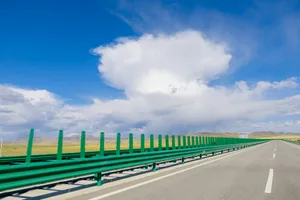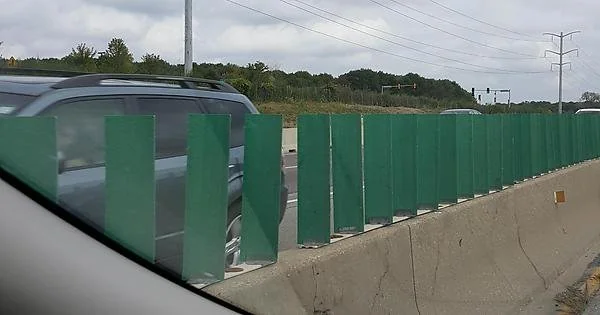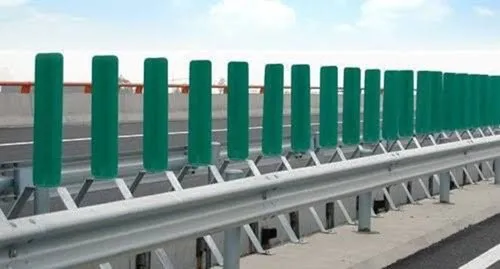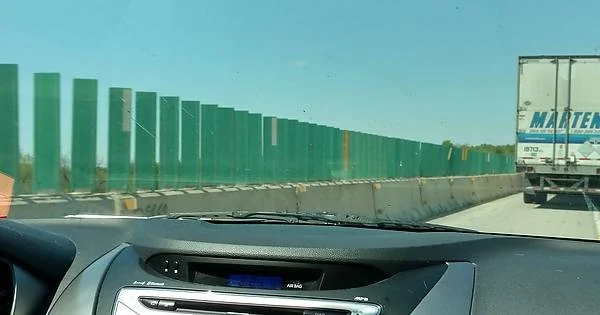If you’ve ever driven down a highway at night, you might have noticed those tall green fins standing along the median between lanes. At first glance, they might seem like just another roadside feature—but these fins actually serve a crucial safety function.
They’re called headlight shields, and their job is to reduce glare from oncoming traffic, improve visibility, and create a safer driving experience—especially at night. But how do they work? And are there other similar traffic control devices helping to keep roads safe? Let’s break it all down.

🚗 What Are Headlight Shields?
Headlight shields, also known as oncoming headlight blockers, are vertical panels installed between lanes of traffic. Their primary purpose? To reduce the glare from headlights coming from the opposite direction, making night driving safer.
When bright headlights hit a driver’s eyes at night, it can cause temporary vision impairment, often called “night blindness.” This momentary loss of vision can be dangerous, especially for older drivers or those with light sensitivity.
By blocking direct beams from opposing traffic, headlight shields help maintain clear vision and reduce eye strain, making roads safer for everyone.
👀 What Do Headlight Shields Look Like?
Headlight shields come in various shapes and sizes, but they all share a common goal: to block glare without obstructing visibility.
✔ Vertical fins or panels – Positioned above highway dividers, they look like thin, upright paddles or slats.
✔ Slightly curved or angled – Designed to intercept and deflect oncoming light beams.
✔ Commonly green or gray – The most frequently used colors, though blue or white versions also exist.
✔ Reflective surfaces – Some shields include reflective materials to increase visibility for drivers.
These shields are often mounted along concrete barriers or median dividers, strategically placed to ensure they block oncoming headlights without obstructing the driver’s own view of the road.
🌙 How Do Headlight Shields Improve Nighttime Driving?
Night driving comes with unique challenges, and headlight glare is one of the biggest hazards. Here’s how these shields make highways safer:
🔹 Prevents blinding glare – Reduces the harsh intensity of high beams from approaching vehicles.
🔹 Reduces night blindness – Helps drivers maintain steady focus on their lane, rather than being distracted by opposing lights.
🔹 Enhances lane awareness – The vertical design of the shields provides a clearer road boundary, making it easier to stay in lane.
🔹 Improves reaction time – With fewer distractions, drivers can respond faster to road conditions.
For highways with heavy nighttime traffic, installing headlight shields can significantly lower accident rates by improving visibility and reducing driver fatigue.

🛑 Other Traffic Devices That Improve Highway Safety
Headlight shields aren’t the only traffic control tools designed to keep roads safer. Many other devices work alongside them to prevent accidents and enhance visibility.
1️⃣ Median Barriers – Physical Dividers for Added Safety
Concrete Jersey barriers, guardrails, and median strips serve as physical dividers between opposing lanes.
✔ Primary purpose: Prevents head-on collisions by keeping vehicles in their designated lanes.
✔ Additional benefit: Reduces headlight glare by creating a taller barrier between lanes.
Some barriers also include reflective strips or built-in headlight shields to enhance visibility at night.
2️⃣ Rumble Strips – Keeping Drivers Alert
Rumble strips are grooved patterns on the road surface that make a loud noise and vibration when driven over.
✔ Purpose: Alerts distracted or drowsy drivers if they drift out of their lane.
✔ Common locations: Highway shoulders, centerlines, and near exits or curves.
✔ Effectiveness: Reduces off-road crashes and helps prevent head-on collisions caused by lane departure.
While they don’t block headlights, they help drivers stay in their lane—reducing the risk of veering into oncoming traffic.

3️⃣ Road Studs & Cat’s Eyes – Guiding Drivers in Low Visibility
Ever noticed small reflective markers embedded in the road? These are called cat’s eyes or road studs, and they provide extra lane visibility at night.
✔ Reflects vehicle headlights, making lanes easier to follow in the dark.
✔ Color-coded system helps drivers navigate safely in fog, rain, or unlit roads.
✔ Durable and weather-resistant, functioning even in harsh conditions.
Used worldwide, road studs offer a simple yet effective way to enhance nighttime driving safety.
4️⃣ Adaptive Headlights – Smart Technology for Better Visibility
Technology is also playing a major role in reducing headlight-related accidents. Some modern vehicles come equipped with adaptive headlights, which:
✔ Automatically dim high beams when an oncoming vehicle is detected.
✔ Adjust beam direction when the car turns, improving visibility around curves.
✔ Reduce glare for other drivers, helping everyone on the road see better.
As more cars adopt smart lighting technology, headlight shields and other anti-glare solutions may evolve to complement these innovations.

🚦 Are Headlight Shields Effective?
So, do headlight shields actually make a difference? The answer is a resounding yes.
According to highway safety studies, areas with properly installed headlight shields see a reduction in nighttime crashes due to:
✔ Less visual strain on drivers.
✔ Improved reaction times when navigating highways.
✔ Fewer instances of lane drifting due to temporary night blindness.
They are especially useful on curved highways, high-speed roads, and multi-lane interstates, where glare from multiple vehicles can create dangerous visual conditions.
🏁 Conclusion – A Small Feature Making a Big Difference
While headlight shields might not be the most noticeable part of highway infrastructure, they play an essential role in keeping roads safer. By blocking intense glare from oncoming headlights, these vertical fins help reduce night blindness, improve visibility, and prevent lane confusion.
Combined with median barriers, rumble strips, road studs, and adaptive headlights, they contribute to a smarter and safer driving experience—especially at night.
So, the next time you see those green fins along the highway, you’ll know they’re not just a random design choice—they’re a carefully engineered solution for safer roads. 🚗💨